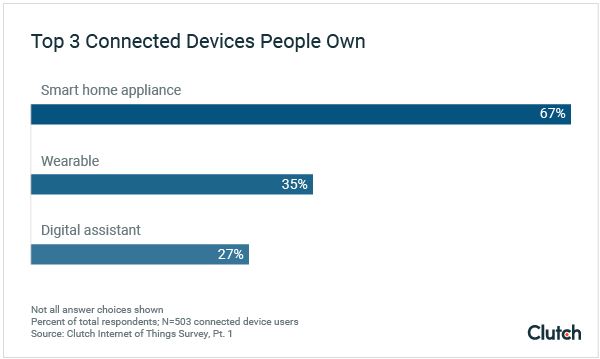Machine Learning and Artificial Intelligence are now central to smart home security

Technology consumers are quickly warming up to smart devices, especially smart home appliances. Yet many users struggle with their maintenance and security, as cybercrooks increasingly capitalize on this newly established attack surface.
Smart home appliances the most popular IoT solutions
According to the latest research on the state of the Internet of Things (IoT), adoption is rising, albeit moderately. Of the solutions that are picking up steam, smart home appliances are the most popular. In a survey by B2B research firm Clutch, 67% of IoT users own a smart home appliance such as a Nest thermostat, smart lock, or smart TV.

Other popular connected devices include wearables (35%) and digital assistants like Amazon Echo or Google Home (27%). However, smart home appliances are the most common connected devices, with 49% saying they use smart home appliances more than any other connected device. Consumers commonly set their home’s temperature on a smart thermostat, pre-heat a smart oven, or set the TV to a favorite channel during their commute home, all through handy smartphone apps.
But research also indicates people don’t rely on their connected devices for day-to-day life. And even fewer people know the dangers associated with the always-on nature of these devices.
Vendors and network providers don’t always do their best to secure data flowing between these gadgets, and bad actors are increasingly apt at hacking smart devices remotely. So smart homes have become an attack vector ripe for the picking.
This expanding attack surface is opening the door to grave new security dangers for individual users. For example, this story about a hacker breaking into a baby monitor remotely to snoop on the mother breastfeeding her child should give anyone the chills. How about unlocking someone else’s smart car with a $300 software-defined radio gadget? Starting now, IoT security needs to be taken more seriously than ever.
Machine Learning and AI
In cybersecurity, Machine Learning is used to recognize patterns that emerge from past experiences and make predictions based on them. For example, it enables new-generation security solutions to react to never-before-seen threats, such as zero-day exploits, or sophisticated attacks, like advanced persistent threats (APTs). However, Machine Learning is part of a broader arsenal for protecting IoT hardware: Artificial Intelligence-based solutions.
Most IT security teams believe a major gap in cybersecurity strategies today is the inability to identify attacks that use IoT devices as a vector. And over 75% agree that even simple IoT gadgets pose serious threats to users. Two-thirds say they have little to no ability to safeguard these products against bad actors.
The majority of IT professionals agree that AI/Machine-Learning technologies are essential for detecting and stopping attacks on IoT devices. According to research by Ponemon Institute, AI-based security solutions will help to: reduce false positives (68%); increase effectiveness (63%); enable more efficient post-attack investigations (60%); find stealthy attacks faster and more efficiently (56%).
One ‘Box’ fits all
“Smart” is no longer just a buzzword. Today’s smart devices are so agile they can make their own decisions based on sensory input, software-based instructions, and even Machine Learning up in the proverbial cloud. Tampered with, however, our beloved smart gizmos can be turned against us. They can be made to malfunction, leak our sensitive information and, in the case of self-driving cars, medical devices and others, even cause us physical harm. Traditional, signature-based solutions provide no safety in the IoT realm. And so, advanced threats call for advanced defense.
Bitdefender intuited this years ago when it started work on Bitdefender BOX – the innovative security hub for the connected home. Bitdefender BOX offers multilayered security for everything from baby monitors, game consoles, and smart TVs to the more traditional computers, smartphones and tablets. Leveraging patented machine learning algorithms and intrusion-prevention systems to pick up new threats and unsafe behavior, Bitdefender BOX knows how our smart homes behave under normal circumstances, and accurately identifies, blocks and alerts users of any malicious activity. Furthermore, no sensitive data gets sent out without encryption – securing credit card information, authentication information and location data.
To learn more about our revolutionary security solution for the IoT ecosystem, visit bitdefender.com/box.
tags
Author
Filip has 15 years of experience in technology journalism. In recent years, he has turned his focus to cybersecurity in his role as Information Security Analyst at Bitdefender.
View all postsRight now Top posts
How to Protect Your WhatsApp from Hackers and Scammers – 8 Key Settings and Best Practices
April 03, 2025
Outpacing Cyberthreats: Bitdefender Together with Scuderia Ferrari HP in 2025
March 12, 2025
Streamjacking Scams On YouTube Leverage CS2 Pro Player Championships to Defraud Gamers
February 20, 2025
How to Identify and Protect Yourself from Gaming Laptop Scams
February 11, 2025
FOLLOW US ON SOCIAL MEDIA
You might also like
Bookmarks







